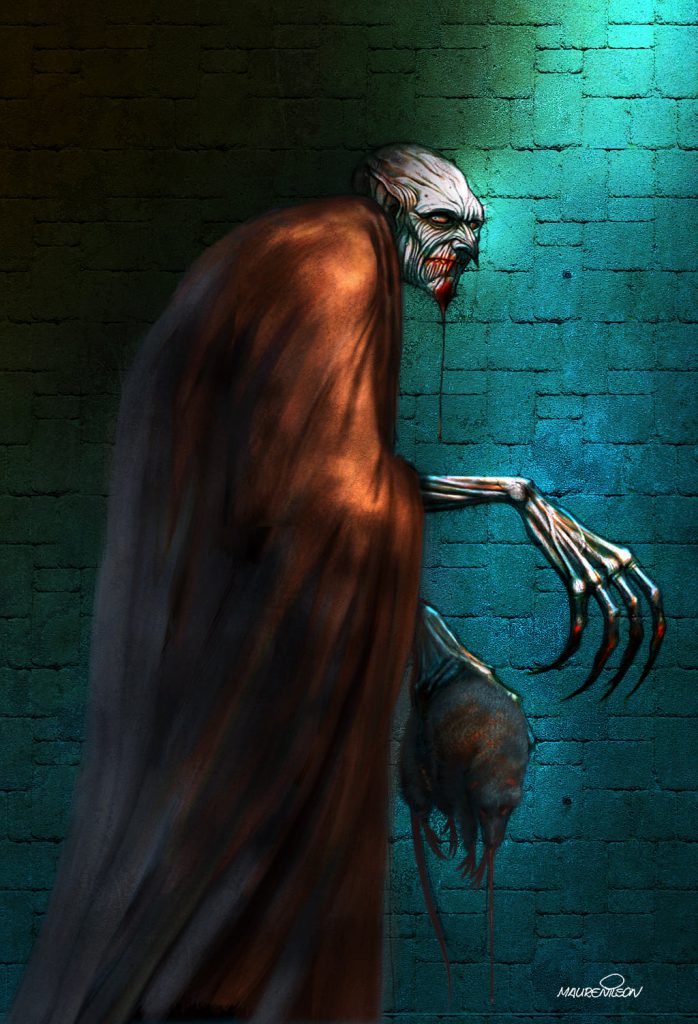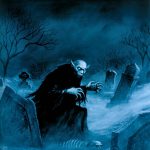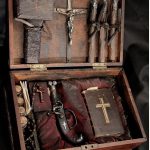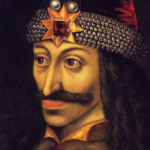Bohemia and Moravia
These two regions today mostly comprise the Czech Republic, with Moravia being east of Bohemia.
The earliest known case of an undead vampire in Bohemia is sometimes referred to in today’s literature as that of “The Blow Vampire.” Most if not all that we know of this today is due to a monk named Neplach (1332- 1368) who was both the abbot of a monastery and a chronicler.
He included the episode in his Summula chronicae tam Romanae quam Bohemicae which was compiled in 1356 and 1362 from previous chronicles written by others. According to this, in the year 1336, in Bohemia near Cadanus [in Modern Czech: Kadan; in Modern German: Kaaden] about a league from a village named Blow [Modern German: Flahe], a shepherd named Myslata died. He resurrected every night from his grave and went around the nearby villages, terrorizing and killing people. When his corpse was being impaled by a stake it said: “They injured me severely when they give me a stick to defend myself from wolves.” .

His corpse was exhumed for cremation. It was found to be ruddy and swollen, and it bellowed like an ox. While the corpse was being delivered on a cart to the cremation pyre, the legs of the corpse drew in as if it were alive. When the corpse was tossed onto the pyre, someone immediately plunged a stake into it and blood gushed forth. After the corpse was cremated, peace returned to the vicinity. Before the cremation, whomever the shepherd’s corpse called by name at night died within the next eight days.
The same case is given in chapter 7, “The Revenants or Vampires of Moravia”, of Dom Augustine Calmet’s Treatise on Vampires and Revenants, published in 1756. Calmet does not seem to have been aware of the antiquity of the case. He gives as his source for this Magia Posthuma by Charles Ferdinand de Schertz, printed at Olmutz in 1706. In this version, the shepard’s corpse is exhumed twice. The first time, it is fixed to the ground with a stake. And the corpse then “derided them for what they made him suffer, and told them that they were very good to give him this stick to defend himself from the dogs.” Later that same night, the corpse arose again and “strangled” more people than before. He was exhumed a second time and “delivered into the hands of the executioner.” The corpse was then both pierced with a stake and cremated just the way the monk Neplach had desribed in his 14’th century chronicle.
Also in chapter 7. of his Treatise on Vampires and Revenants, Calmet gives information concerning the vampire in Moravia and Silesia based on de Schertz’s Magia Posthuma. According to this, such spectres often appear in the mountains of Moravia and Silesia. They can appear at day or night. But things that belonged to them can sometimes be seen to move about as if by themselves. And in some case that occurred in a village in Moravia, the revenant of a woman sometimes appeared in the form of a dog, sometimes that of a man for four days after her death. She caused great pain to some those to whom she appeared. She grasped their throats and compressed their stomachs, “so as to suffocate him.” The only ways to get rid of these revenants are decapitation and cremation. A trial by law is usually held to determine if the circumstance warrant such treatment of the corpse. If the corpse is exhumed, it is not handed over to the executioner for decapitation and cremation for six or seven weeks. If it is already decaying when exhumed, it is reburied. If it begins to rot within the six or seven weeks, it is also reburied. But otherwise decapitation and/or cremation follow.
In chapter 51, Calmet also includes information he had personally learned from a priest who had been sent into Moravia. After arriving in the city of Olmutz,he was soon invited to join a local official in his investigation of a recent case of a revenant in the village of Liebava. According to the witnesses who testified there,three or four years before the revenant of a man who had died had come out of the cemetery at night to disturb people in their beds. The trouble he caused ceased when a “Hungarian” happened to arrive in the village on his way to some further destination. This traveler boasted that he could put an end to the revenant’s activity. He climbed up the church tower and observed the revenant coming out of its grave. The revenant removed his linen burial shroud and then went off to do his usual mischief. The “Hungarian” then quickly climbed back down to the grown, ran to the cemetery, and snatched the shroud. Then he carried this shroud back with him back to the top of the tower. When the revenant returned to his grave site, he saw that his shroud was missing. Then he spotted the stranger up on the tower. The man signaled to to the revanant by way of gestures that he ought to climb up the tower and get his shroud back. The revenant was soon climbing the ladder that the stranger had used. But, when the revenant was nearly to to the top, the stranger knocked him backwards off the ladder. After climbing down again, the “Hungarian” then decapitated the corpse with a spade. The revenant never troubled anyone again.
In the above paragraph, I have put the term Hungarian in quotion marks since Calmet and other writers in his day use the term to mean anyone living in what was the Kingdom of Hungary, which then included northern Serbia and parts of Romania. Most often in accounts of vampires written at this time, the “Hungarian” is revealed by geographic and ethnic details to actually be a Serbian.








